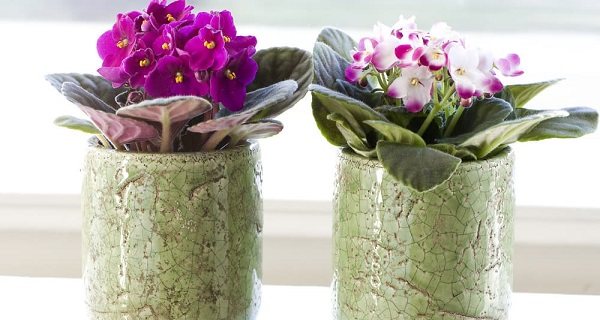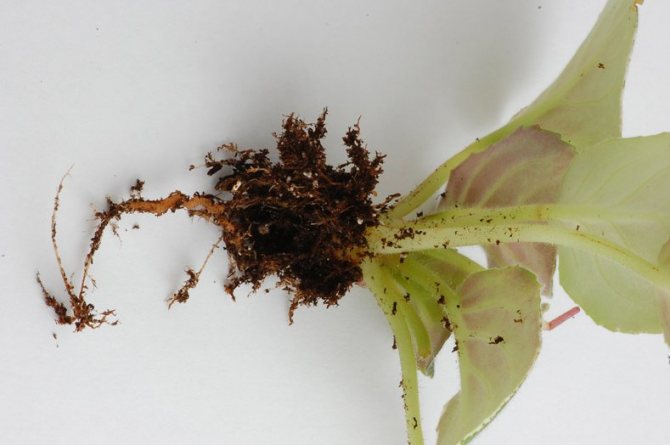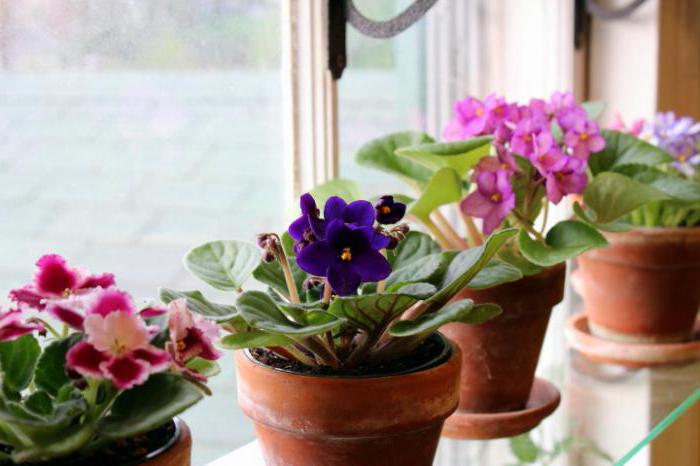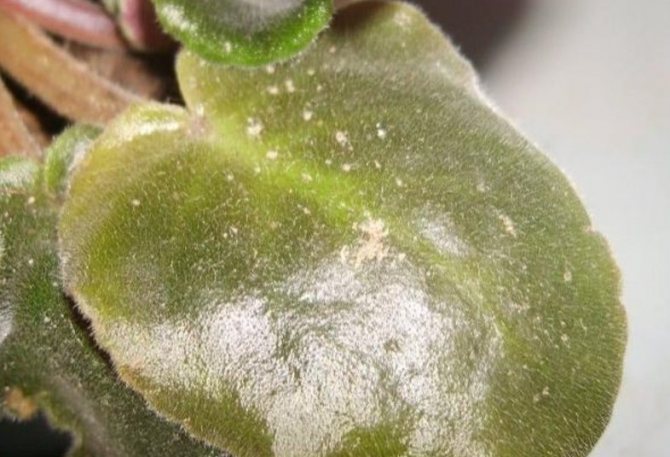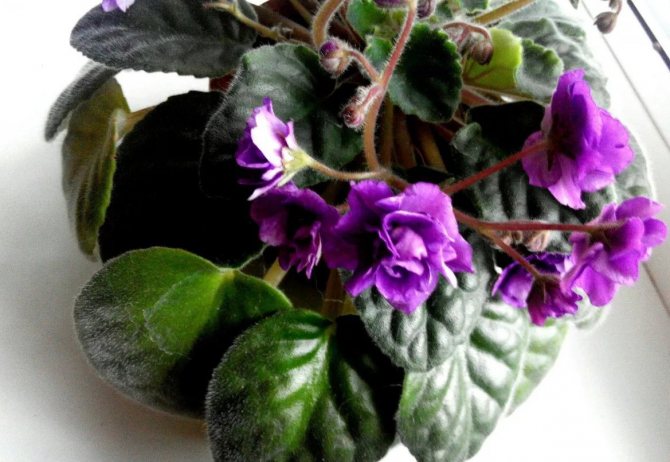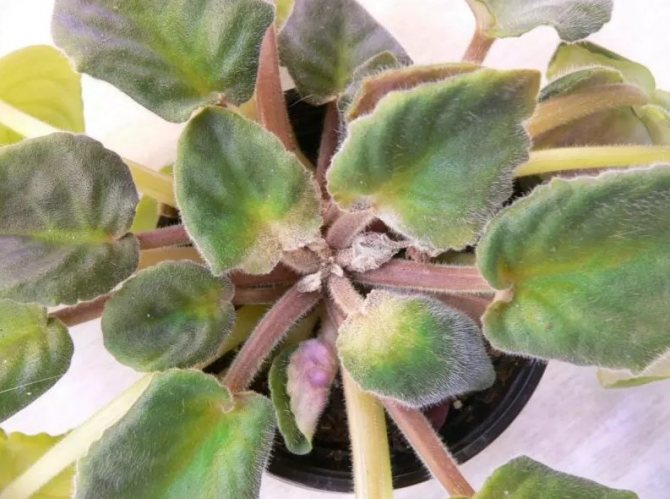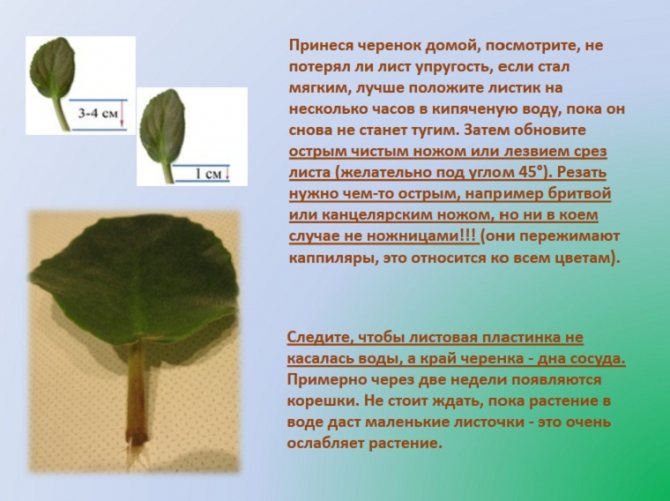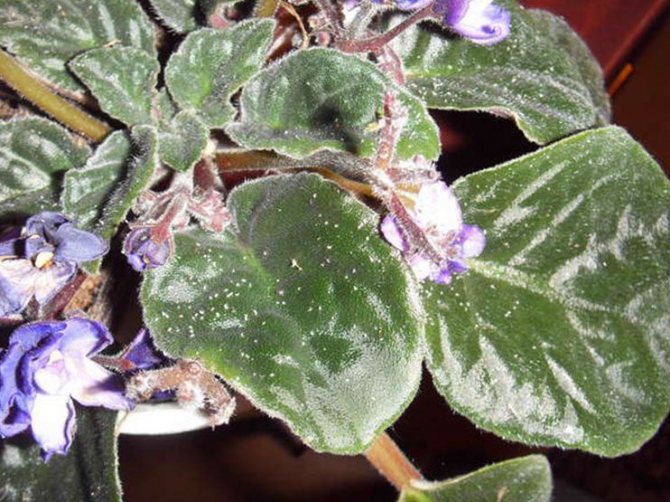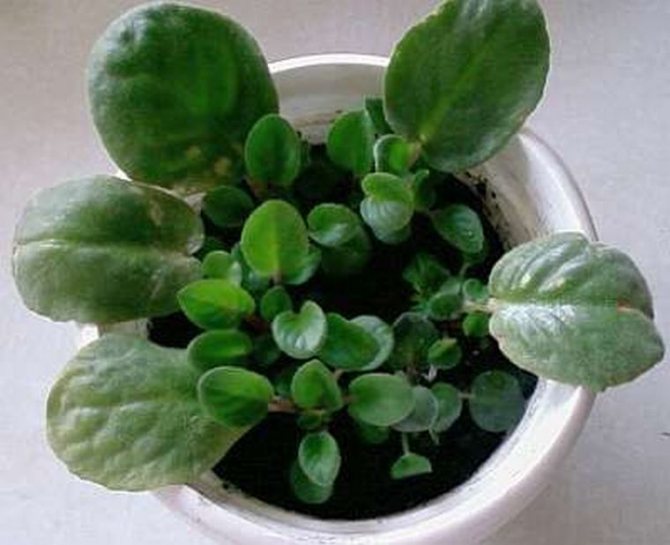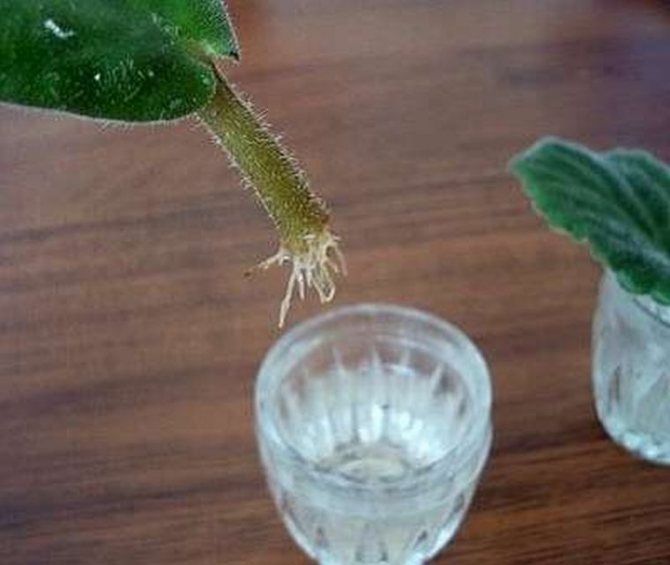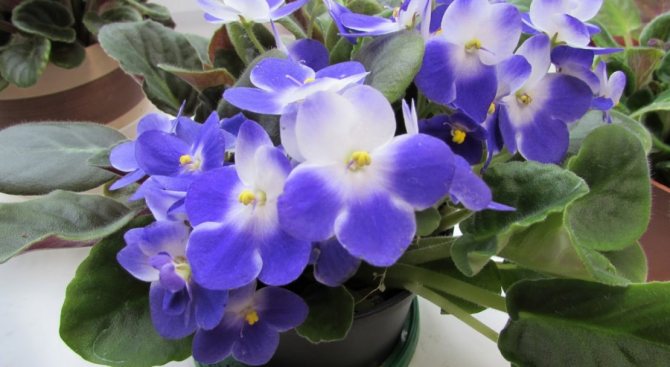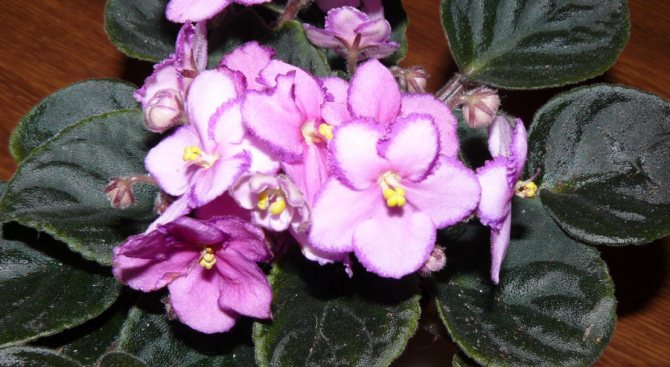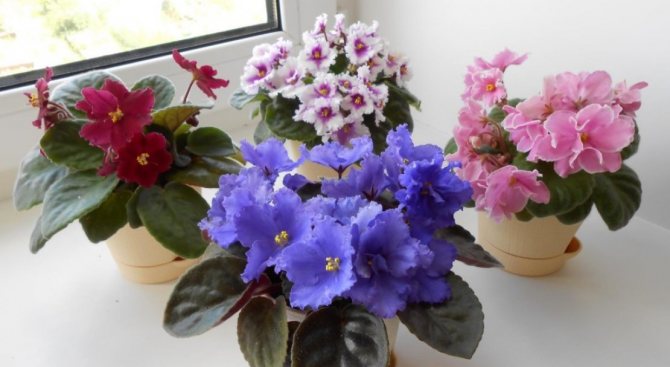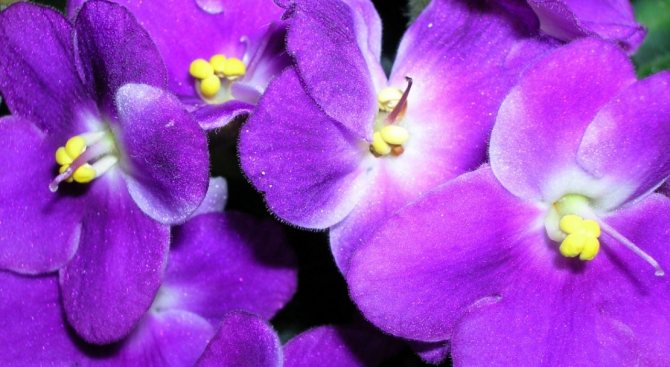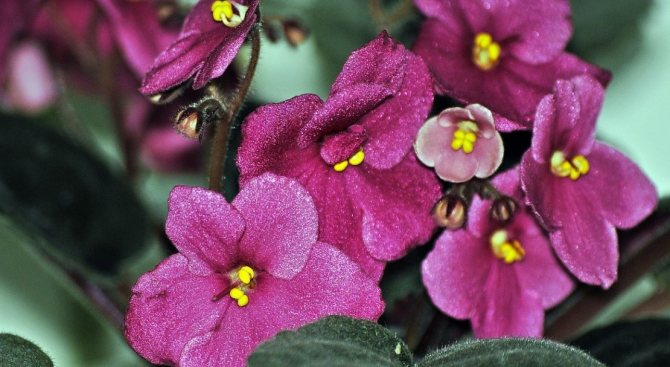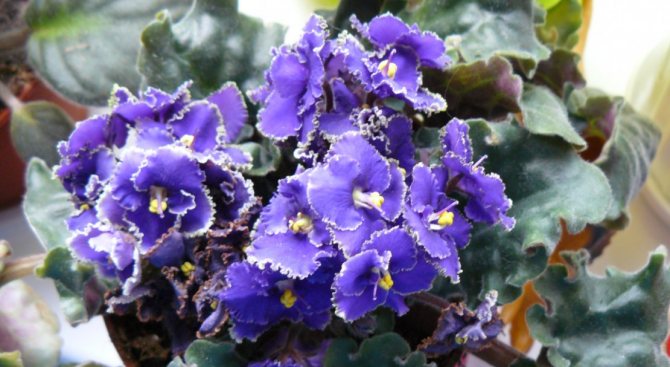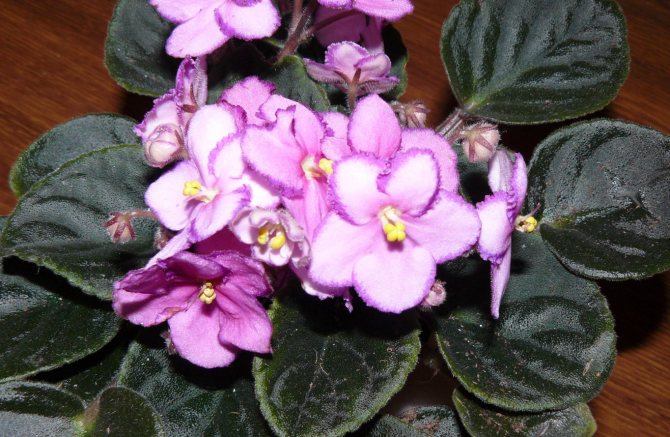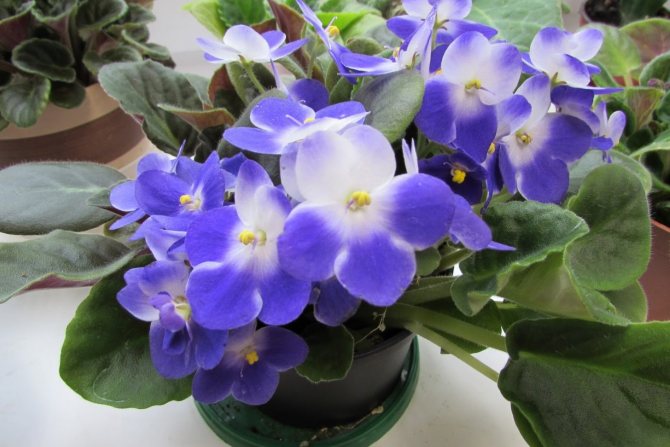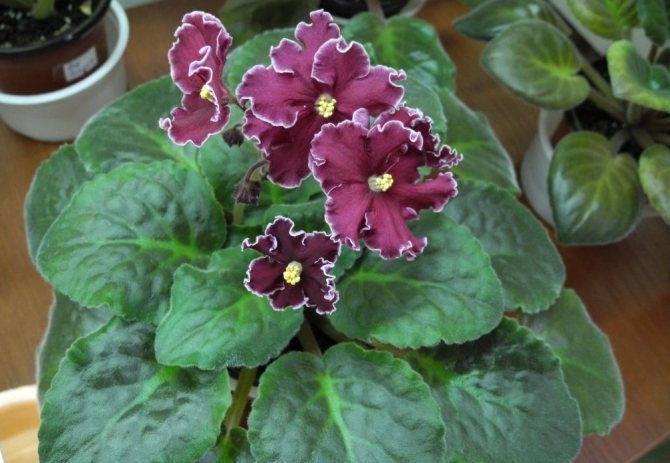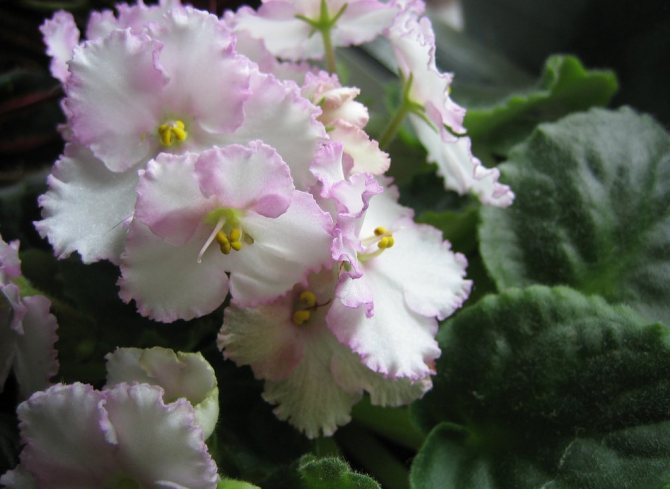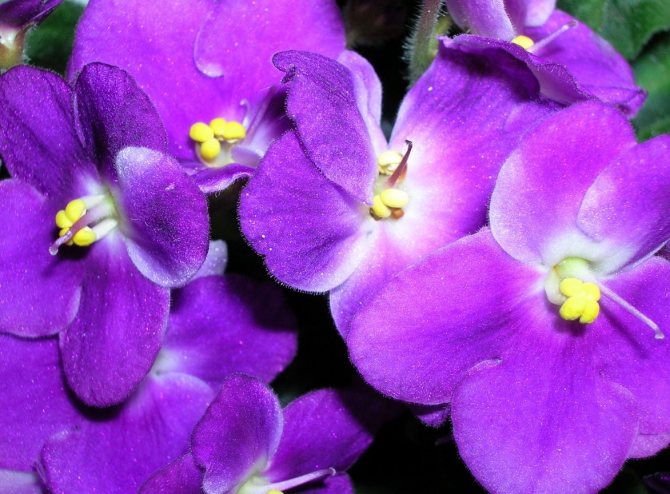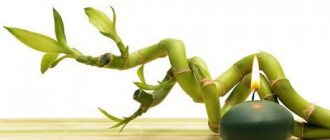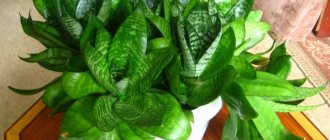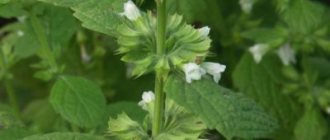Saintpaulia is a genus of flowering plants of the Gesneriaceae family. One of the most popular indoor flowers. There are a huge number of varieties of Saintpaulias, or, as they are called, "Uzambara violets". You can choose almost any variety with the desired size and color. Compact bright plants that can bloom almost all year round. Let's take a closer look at what kind of indoor flowers are, and how to care for them.
Don't confuse Saintpaulia with Viola. These are two different genera belonging to completely different families. Saintpaulia, aka Uzambara violet, belongs to the Gesneriaceae family and is a tropical plant. While the Violet, known to us under the general name "Pansies", belongs to the Violet family and is grown as a garden plant.
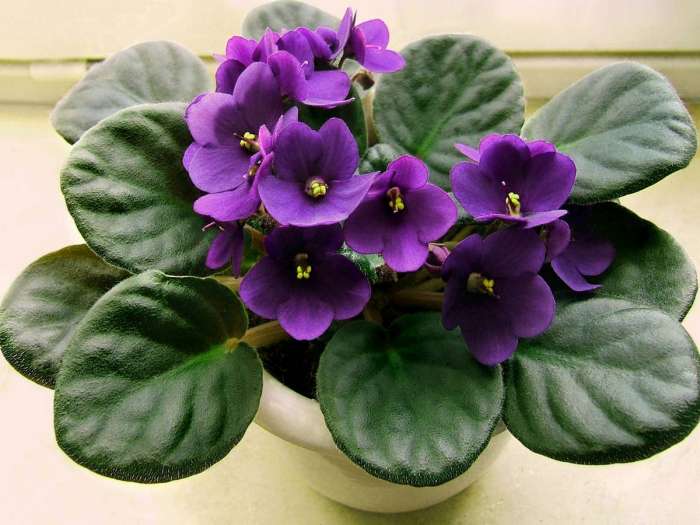
Saintpaulia, or Usambara violet
FEATURES OF GROWING
The conditions for caring for violets are not very different from growing any other indoor flowers. But in order to grow a full-fledged, regularly and abundantly flowering plant, you need to have some experience and knowledge.
Saintpaulias need good light, moderate watering, sufficient air humidity, and an optimal room temperature. The saturation of the color of the leaves and corolla of violets depends on this.
Plants do not like drafts, sudden changes in temperature and light, they need rest in winter, although they can bloom all year round.
ATTENTION! With insufficient care in winter, violets die.
The novice breeder Senpauliy will first use the advice and recommendations of experienced flower growers, but later, using various methods, he will learn how to properly care for violets and will find the middle ground that will be optimal for the area and apartment in which the plant is grown, and for its specific species or variety.
Varieties
The Uzambara violet is subdivided into types according to several criteria:
- the size of the flower rosette (from 5 to 20 cm in diameter);
- the type of flower, taking into account its shape, color and size;
- characteristics of sheet plates and their appearance (simple or variegated);
- the size of the plant.
There are varieties of violets that are called fantasy: for example, varieties "Julia" and "Aphrodite". They are characterized by an unusual color of petals, because on their monochromatic surface there is always a multi-colored addition in the form of dots, spots, stripes, which gives the plant even more decorative effect.
Among the most interesting and common varieties of this plant are the following:
- "Chic poppy" - has large flowers, the color of which ranges from light pink to dark orange. All flowers have wavy edges of the petals, reminiscent of frills.
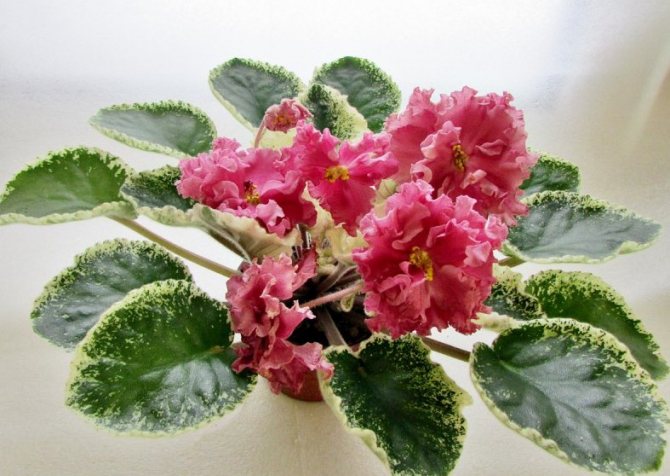

- "Royal Grace" - characterized by large simple or semi-double flowers, bordered by a crimson edging. The leaves are dark green.
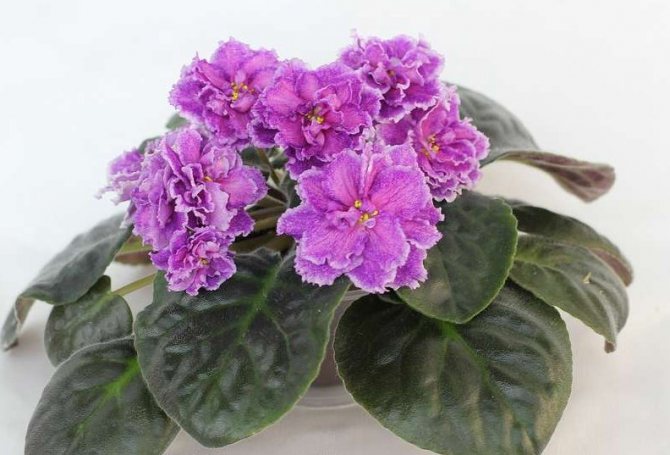

- "Spring rose" - a profusely flowering variety, on which a large number of snow-white flowers appear, with a greenish tint. The leaf plates are medium in size, deep green in color.
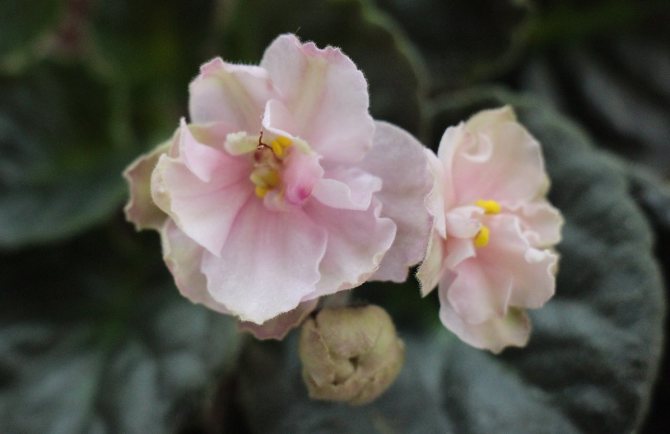

- "Snow lace" - has large double flowers, pure white with a yellow center. The leaves are dark green.


- "Blue Mist" - a light blue flower of medium size, with a more saturated middle part of the petals and a white ending. The petals are slightly wavy, the leaves are light green in color.
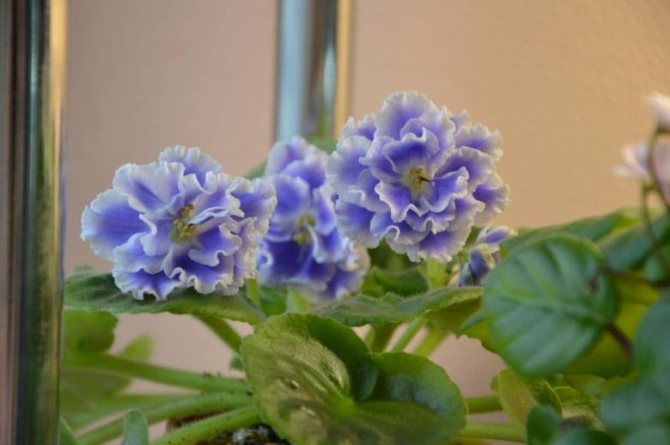

In addition, no less attractive varieties of Saintpaulias are Duchess, Frosty Cherry, Blue Blood and Summer Twilight, among which both double flowers and specimens with slightly wavy edges will be equally interesting.
LANDING
Planting methods
There are several ways to grow Saintpaulia:
- seeds
- cuttings
- dividing the bush
- peduncles
- leaves without petioles
- socket
- pinching
Planting Saintpaulia seeds is not an easy process. Violet seeds are small and therefore require special attention. Various methods of "enlarging" the seeds are used to distribute them evenly over the soil.
For cuttings, take leaves with a short petiole or one plate. Division is used when Saintpaulia grows strongly. Planting violets with a rosette is used to "rejuvenate" the plant. Planting with a peduncle is applied to varieties with an unusual color if, when planting with a leaf, it is not possible to obtain the desired color of the petals.
The separation of daughter outlets - stepchildren from the plant - is called transplantation. They appear between the leaves of the buds that form on the stem of the violet. With this method, the new plant has the same colors of leaves and flowers as the mother.
ATTENTION! When Saintpaulia is planted with a leaf cuttings, seeds, the young plant does not always inherit the maternal traits. Sometimes they have a different color of the corolla or leaves.
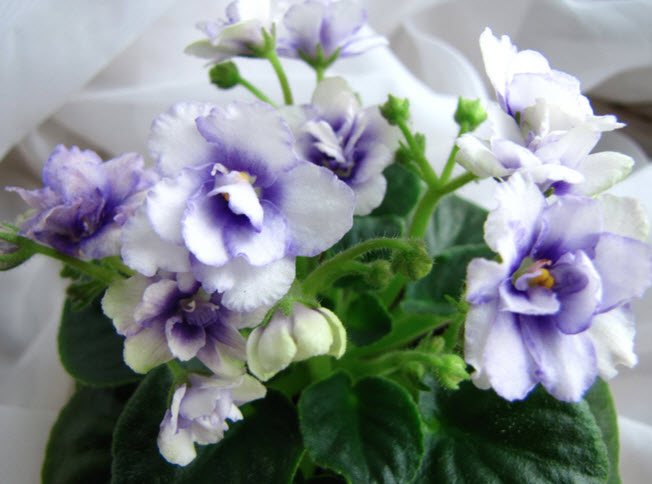

Time to board
Planting Saintpaulias is best done in spring or summer. For successful rooting, they need bright light. In winter, under the condition of insufficient air temperature and high humidity, the planting material can rot and die.
Soil for planting
To plant violets, the soil must be loose, with a low level of acidity and many nutrients necessary for a home flower. It is necessary that it absorbs water well and allows air to pass through.
You can use a landless type of soil, which includes:
- peat
- perlite
- vermiculite
In such mixtures, the flower begins its growth successfully.
In other cases, sod land, moss, peat, sand are mixed, charcoal is added. You can combine garden soil with coniferous, add sand, sphagnum and ash for nutrition.
The composition of the soil depends on the saturation and acidity of the garden or turf soil included in the soil for the violets.
You can use a mixture purchased in stores or from private collectors and flower growers.
Before applying the soil, it is better to disinfect it. This can be done by sprinkling it on a baking sheet and placing it in a hot oven, or putting it in a cloth bag and steaming it well over boiling water.
Landing rules
Violet flowering depends on the correct development of the root system. Therefore, you should choose a small pot for Saintpaulia. For planting a small process in the form of a rooted cutting or stepson, as well as a sprout grown from a seed, a very small container is suitable, the diameter of which can be only 5 cm. It is recommended to sterilize the pot before planting.
As the home flower grows, the pot is increased. For planting an adult specimen, the pot can be about 10 cm wide.
The violet must be planted very carefully. It should be right in the center of the pot and the roots should be well spread. It is necessary to control that the legs of the lower leaves are flush with the soil. Subsequently, when the leaves are well formed, they should be halfway beyond the edge of the pot.
ATTENTION! How the initial planting of violets will be made will determine its further development, duration and abundance of flowering.
What to look for when buying saintpaulia?
First of all, when buying Uzambara violets, you should pay attention to the leaves. If you find any suspicious spots or a too tight growth point on them, then, for sure, this plant is affected by some kind of disease. Even for a specialist it will be difficult to grow and leave such a flower, but for a beginner it will be almost impossible. Therefore, it is better to choose a plant with bright green leaves, without signs of pest damage.
When choosing a baby, it is important that the leaves are not very elongated - this indicates that the plant has already suffered from a lack of light.
For reproduction of Saintpaulias, it is best to take a leaf cutting from the second bottom row. The lower leaves also give children, but, as a rule, they are more emaciated due to their venerable age, so the offspring will certainly be weaker.
And be sure to ask the seller to indicate the varietal affiliation of the plant, so that later you do not suffer with the identification of the Saintpaulia variety. Some collectors on the tag with the variety indicate the date of planting of the baby.
For transportation of leafy cuttings of Saintpaulia, it is convenient to use boxes, plastic containers or other containers that will not allow the cuttings to break when transported in public transport. If such a container is not at hand, then ask the seller to inflate a plastic bag and tie it tightly, in this case the stalk will not be injured during transportation. If, nevertheless, the leaves are broken, then they must be removed from the outlet.
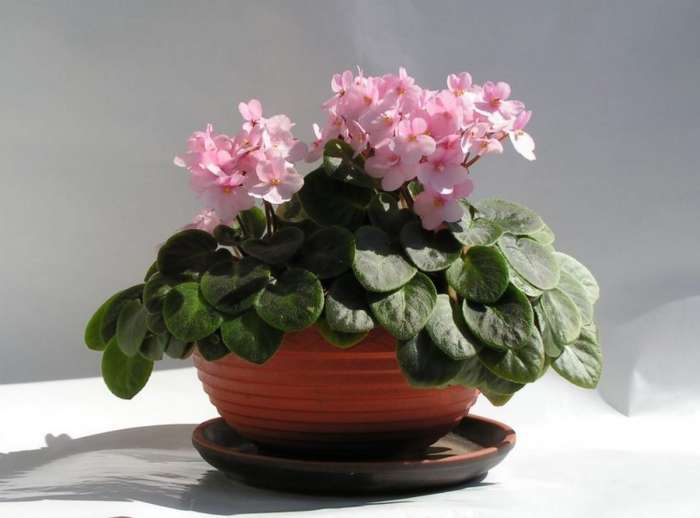

Saintpaulia, or Usambara violet
When choosing pots for Uzambara violets, their size is important, namely, diameter. It should be 5-6 cm for children and young outlets, for adult outlets no more than 10-12 cm. Ideally, the diameter of the pot for an adult outlet should be 3 times smaller than the diameter of the outlet itself.
Both plastic and ceramic pots are suitable for Saintpaulias. Nowadays, collectors prefer to grow Uzambara violets in plastic pots, because they are cheaper and more convenient.
CARE OF SENPOLIA
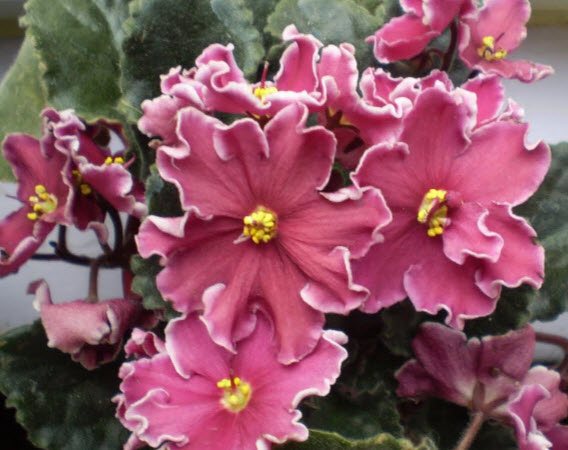

Lighting, location
Saintpaulia prefers a lot of bright, but diffused light. For this, any windows are suitable, except for the northern ones. Some growers use artificial lighting throughout the year to control the level and duration of the light.
Photosynthesis in flower leaves is most active in the morning and evening. Therefore, it is at this time of day that the plant most needs light.
During winter lighting, violets continue to bloom. If there is no need for their year-round flowering, Saintpaulia can be kept in normal light in winter. At any time of the year, the flower must be protected from direct sunlight.
Several pots with a plant should be placed at some distance from each other, so that the leaves do not touch each other.
Humidity
Air humidity for Saintpaulia should be about 50%. The violet does not require additional spraying. Contamination from hairy leaves is carried out with a dry brush. If, nevertheless, there is a need to wash the flower, then the leaves must be dried well before being put on the windowsill.
Temperature
The air temperature for violets needs about 25 degrees. The plant is able to withstand both higher and lower temperatures. But it shouldn't be less than 15 degrees, and it shouldn't be much higher than 30.
Watering
Water the violet with warm, settled or boiled water. Water temperature and ambient temperature should be approximately the same. The difference can be 4 - 5 degrees.
Watering Saintpaulia needs to be very moderate. Stagnant water is one of the causes of plant death. The roots or trunk can quickly rot. If such a nuisance does happen, it is necessary to transplant the flower into dry ground.
Water the violet as the soil dries up.The soil is completely shed. In order not to stagnate the water in the pot, for planting it is necessary to use a container with holes in the bottom and a pallet.
ATTENTION! Excessive soil moisture is especially dangerous for the plant in winter.
FEEDING AND FERTILIZERS
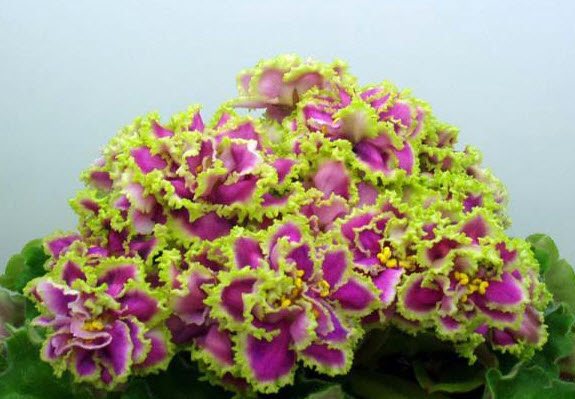

The home plant needs feeding with the necessary substances. The most necessary for him are phosphorus, nitrogen, potassium and other minerals and trace elements. Dry fertilizers are used during planting by adding them to the soil. Liquid species are diluted with water at the desired concentration, which depends on the regularity and frequency of feeding.
If fertilizers are applied infrequently, the concentration should be in accordance with the directions on the package. When using fertilizers, with each watering, the substances are diluted in water with a weak solution.
From March to autumn, you can feed the violet every two weeks or a little more often. In the autumn - winter period, once a month is enough.
For the optimal combination of all nutrients, you can use complex fertilizers, which contain everything you need for the proper development of the flower. If fertilizers with a high content of a specific mineral are used, then such dressings must be alternated.
A mixture of humus, sand, ash and sawdust can be used as fertilizer. All this must be mixed, finely grated and sprinkled with soil in the pot about once a month.
Growth, quality of leaf mass, abundance and duration of flowering of violets depend on the enrichment of the soil with useful substances.
Varieties and types of Saintpaulia
Saintpaulia has about twenty plant species.
The most famous types:
- Saintpaulia dark (Saintpaulia confusa) - a plant with a slender, straight stem up to 10 cm high. The flowers are bluish-purple, with yellow anthers, collected in clusters of four.
- Saintpaulia violet-flowered, or Violet Saintpaulia (Saintpaulia ionantha) - in nature, the plant has violet-blue flowers, while cultivars bred, the color can be very diverse: white, pink, red, blue, purple. The leaves are green above, greenish-reddish below.
- Saintpaulia Magungen (Saintpaulia magungensis) is a plant with branched stems up to 15 cm high and leaves about 6 cm in diameter with wavy edges. The flowers are purple, collected in two or four.
- Saintpaulia teitea (Saintpaulia teitensis) - a rare species from the mountainous regions of southeastern Kenya, subject to protection.
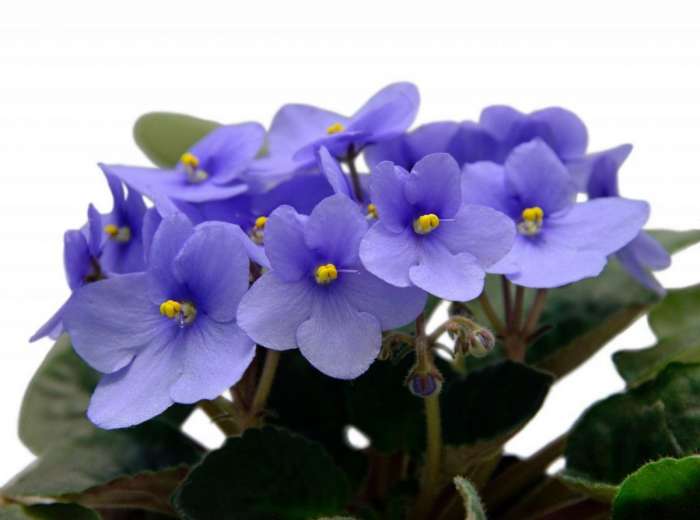

CUTTING
The decorativeness of Saintpaulia includes the compactness of the leaf rosette and the number of flowers. In order for the violet bush to be neat, pruning is carried out. Its full development, including flowering, depends on the removal of excess parts of the plant. Unnecessary shoots and leaves do not take away some of the nutrients, and the violet grows more harmoniously. A very sharp and clean tool is used for trimming.
In an adult plant, new leaves often appear in the center. To enable them to fully develop, old, root leaves must be removed. For this, the largest and oldest plates are selected and removed along with the cuttings. The cut must be done obliquely and very carefully, without damaging the flower. For a violet, three rows of leaves are enough.
They also cut off obsolete peduncles and extra stepchildren, which appear from time to time, and break the symmetry of the outlet. They must be removed by separating them from the stem.
Each grower observes the beauty of the Saintpaulia bush independently and forms a rosette at his discretion.
Acquaintance with species diversity
Evergreen undersized potted plants belonging to the Saintpaulia species, regardless of the variety, have common characteristics by which people immediately recognize the indoor violet among all the flowers.
She has a shortened stem, leathery leaves are collected in a rosette so that it appears as if they are growing directly from the ground.The leaves are covered with villi and resemble velvet to the touch.
The shape is rounded, the tops can be either rounded or pointed. Green coloration is uniformly light, dark, or stained.
The sizes of ordinary violets are from 20 to 35 cm across the leaf rosette. However, the breeding and reproduction of hybrid varieties with unusual sizes is now very active.
So, large varieties can have a diameter of more than 40 cm (ie, one leaf is more than 20 cm long), and miniature varieties - only 7-14 cm (ie leaves less than 3.5-7 cm).
The flowers of an ordinary violet, collected in a brush, have five petals and five sepals. Semi-double varieties have 6-10 petals, terry varieties have more than 10 petals per flower. The edges of the petals are smooth, corrugated and wavy.
After the violet has faded, its small seeds ripen in small capsules - fruits.


In the photo, the main types of Saintpaulia with names
Saintpaulias bloom not simultaneously and almost continuously, regardless of the season. Flowers have a whole rainbow of shades: from white, yellow and pink to purple, blue and violet.
The varieties have been bred that have flower petals with strokes, “fantasy” spots and edging.
Recently, Saintpaulia chimeras have come into vogue. They have a distinct stripe of a different color on each petal.
They reproduce not like ordinary violets, but with a cut off top and stepsons. Unfortunately, not all children repeat the colors of the parent, but turn into ordinary monochrome violets.
Saintpaulias of different varieties in the photo selection will help you get acquainted with all the beauty of the plant:
TRANSFER
Goals and methods of transplant
It is best to transplant Saintpaulia in spring or summer. Young flowers are transplanted as they grow, and old ones - once or twice a year. Violet transplant is carried out for several purposes:
- increase the volume of the pot
- rejuvenate the plant
- replace partially or completely the soil in the pot
- deepen the plant
If it is necessary to transplant Saintpaulia into a more capacious pot, use the method of transshipment of the plant. To do this, remove the violet from the container along with a lump of earth, transfer it to another, place the plant in the required position and add a layer of missing soil. This method is used for young specimens.
With a partial replacement of the soil in the pot, the plant extracted with a lump of earth is slightly freed from the old soil. Remove those parts of it that easily fall off the roots, including the top layer, in which the root system has not grown.
When replacing the soil, it is necessary to completely separate and unravel the roots and clean them of caked and compacted soil. Very long parts of the root can be cut off, leveling its shape. This procedure is painless for violets. It is not necessary to flush the root system. After the plant is prepared for planting, you need to place it in a pot and cover it with soil. This method of transplanting is suitable for old, overgrown flowers.
Plant rejuvenation is carried out when the violet began to look insufficiently decorative, the lower leaves are dead or removed for reproduction, and the stem is bare. For such a transplant, take out the Saintpaulia from the pot, break off the leaves that have become unusable, and with a sharp knife remove half of the root system along with the earth. Then they put the violet in a pot with a pre-prepared drainage and add the missing volume of soil.
In the second method, the root is cut off completely, leaving quite a bit, then the remaining part is cleaned and the bush is placed in the water so that it does not touch the leaves. After the violet takes root, it is planted in the ground. In this way, Saintpaulia can be rooted directly in the substrate.
Rejuvenation of the violet is necessary for the old plant to regain its decorative effect.
Violets - leaf propagation, rules, features, nuances
With the help of seeds, these flowers are bred by growers engaged in the development of new varieties.
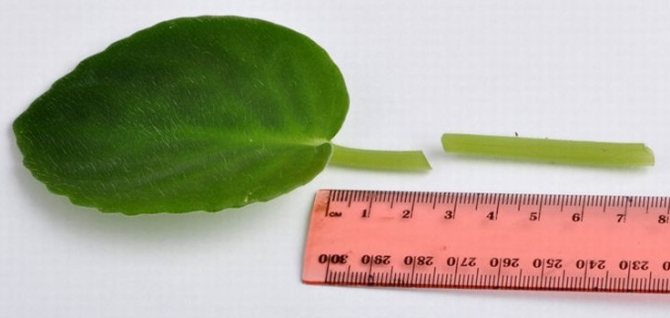

At home, the uzumbar violet can multiply by shoots or leaves - the so-called cuttings. It is very easy to plant an offshoot or leaflet that has taken root in a pot with moist soil - and after a while you will have a mature plant.
Reproduction of violets by a leaf, at home, is carried out as follows, the leaves are plucked immediately under the flower stalks or the leaves of the second tier. Such leaves should be grown, mature, have a stem of 3-4 centimeters. They are cut off at an angle with a thin-bladed knife and placed in settled water. All leaves require their own space - therefore, each has its own container of water. It is not customary to replace water entirely, but it will need to be added when the level in the container decreases.
After the roots appear, the leaves are planted in pots with a slope, while making sure that the leaf does not lie on wet ground (for this, you can put something under it, for example, a piece of plastic, a small stone). The earth around the leaf is not tamped, but left loose. From such a leaf, small young leaves will grow, which will gradually form a rosette. When young leaves begin to grow, the planted leaf can be trimmed. Typically, several small plants grow in a pot. Then they are divided and seated in different pots.
REPRODUCTION
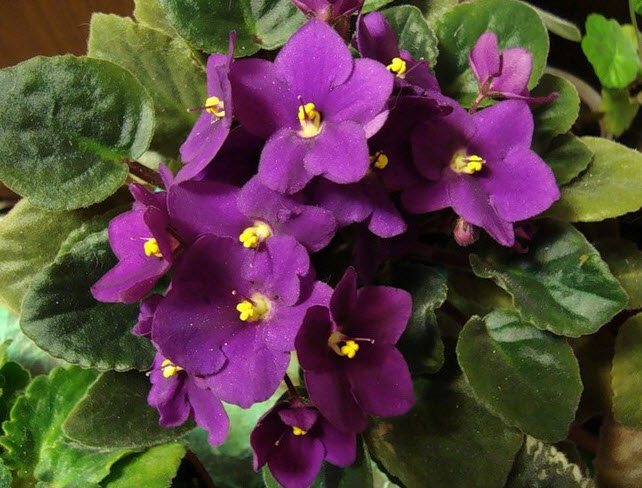

Reproduction of violets is not a complicated enough process. It is used when they plan to increase the number of independent plants on the windowsill and replenish the collection with new specimens.
There are several ways to breed Saintpaulia:
- leaves
- daughter stepchildren
- peduncle
- seeds
Leaf propagation is the simplest and most common method. For this, the outlet is examined and a healthy, bright and evenly colored leaf is selected, which is taken not from the center and not from the very bottom of the plant. It is cut at an acute angle and takes root in water, soil, vermiculite. When rooting in water, you need to take clean boiled water and watch the cuttings. When decaying, the end of the petiole must be cut off and the process repeated.
When planting a plate in the ground, you need to monitor the appearance of children, then pull them out of the ground, separate them and plant them in separate pots.
Stepchildren are appendages that grow out of the kidneys. They are removed due to the fact that they retard the growth and flowering of the plant. For reproduction, stepchildren are taken with several leaves and rooted in any way: in water, vermiculite or directly in prepared soil. You need to cut off the shoot with a sharp knife or other device right at the stem.
The peduncle for reproduction is taken from a faded plant. For rooting, leave the middle of the peduncle - you need to cut it slightly above the stipule and slightly below. The resulting "trim" must be placed in the ground, for example, in a disposable sakanchik, and wait for rooting.
Germinating violet seeds is quite painstaking. The seeds are very small and cannot be planted individually with the required uniformity. Therefore, the so-called pelleting is carried out. To do this, mix wet seeds with fine charcoal and mix well. The seeds are covered with coal dust and become larger in size.
Then they need to be sown on the soil surface and covered with glass. The optimum temperature for germination is about 25 degrees. The sprouts will appear in a few weeks. When several leaves appear, the germinated seeds dive at some distance from each other. The resulting sprouts are planted in separate pots.
When propagating in any part in the soil, it will be better if the container is closed after planting with polyethylene to create the required temperature and humidity.
Botanical description of the plant
Usambara violets came to our homes from Africa and are valued by many growers for their abundant and long flowering, which does not require too much care. All Saintpaulias are low or squat flowers with a height of 5 to 50 cm. Some varieties can be grown as ampelous crops, pleasing the eye with lush flowering. The stem is shortened, and in its upper part there is a rosette with many long-petiolate leaf plates. Their shape and texture depend on the type of flower, so the leaves of these violets can be ovoid, round, oval or heart-shaped.
Fluffy spraying is almost always present on the surface of the sheet plate, but in some cases it is hardly noticeable. Depending on the variety, the color of the leaves varies from light green to dark green, and in the lower part, the leaf blade can be painted in a pale purple color. In almost all violets, the leaves are covered with veins, visible to the naked eye.
Violet buds are small, but numerous, therefore, during flowering, up to 100 flowers can simultaneously bloom on one plant. Considering that today there are more than 1000 species of different violets, it is not surprising that it is very difficult to describe all the possible colors, shapes and textures of their petals. They can be simple, with a fringed border, embossed and wavy, with a variegated or monochromatic color. At home, you can find blue, blue, purple, white and pink flowers, as well as a variety of combinations of these colors.
Did you know? Many folk signs are associated with violets. For example, on a dying plant, it is recommended to calculate the total number of flowers: an even one indicates a quick monetary profit, and an odd one promises losses. That is why, during transplantation, it is advisable to choose the moment when the plant will have exactly an even number of flowers.
BLOOM
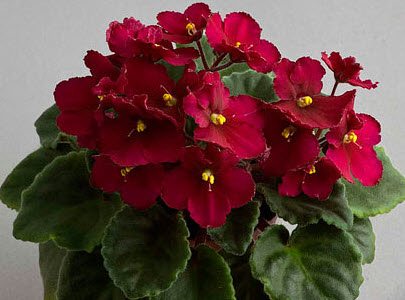

When and how Saintpaulia blooms
With favorable conditions and quality care, Saintpaulia can bloom almost all year round. To do this, she needs a small pot, moderate watering without excess, timely feeding, especially during the growing season, regular removal of shoots, flourishing corollas and peduncles, daylight hours for at least 12 hours. A violet planted from a leaf will bloom in about six months.
What to do after flowering
After abundant flowering, the violet needs rest for two to three months. She needs to remove the lower leaves and transplant into new soil. It will be possible to water it in a few days, by that time the wounds on the stem and roots will heal.
Types of violets
According to the color and the number of petals in the corolla, violets are divided into several types:
- simple
- bicolor
- rimmed
- fantasy
- chimeras
- terry
- semi-double
Simple violets have five rounded petals in the corolla, two of them are slightly shorter than the others. The colors are different, but monochromatic.
Bicolor has five petals, two-colored.
Star-shaped corollas consist of five slightly pointed petals, which makes the flower look like a star.
In the case of the rimmed ones, the petals are framed by a white rim.
Fantasy violets have contrasting dots and spots on the petals.
In chimeras, in the center of the petals, stripes of a color different from the petal itself are located.
Semi-double and terry have additional petals in the center of the corolla. Semi-double ones have 2, and terry ones have several.
The history of the discovery and distribution of Saintpaulia
The Uzambara violet was discovered in 1892 by Baron Walter von Saint-Paul (1860-1940), the commandant of the Uzambara district, a German colony located on the territory of modern Tanzania, Burundi and Rwanda. Walter Saint-Paul noticed this plant while walking. He sent the collected seeds to his father, the president of the German Dendrological Society, and he gave them to the botanist Hermann Wendland (1825-1903).Wendland raised the plant from seed and in 1893 described it as Saintpaulia ionanta (Saintpaulia violet-flowered), separating this species into a separate genus, which he named after Saint-Paul's father and son.
For the first time, Saintpaulia was presented at the international flower exhibition in Ghent in 1893. In 1927, Saintpaulias came to the United States, where they immediately gained popularity as indoor plants. By 1949, a hundred varieties had already been bred. Today the number of varieties exceeds 32 thousand, of which more than 2 thousand are domestic.
PROBLEMS, DISEASES, PESTS
Pests
The violet can be damaged by pests. These can be thrips, ticks, aphids, mealybugs. All insects, except for the worm, which lives in the soil, infect the ground parts of the plant. Their presence is noticeable in different changes in violets. Brown, red or white dots and spots appear on the leaves, they wither, flowers and buds fall off. The individuals themselves and their larvae can be seen by carefully examining the bush. They live on all parts of the plant, including the underside of leaves and buds.
Sometimes washing the violets under running water for several days helps in the fight against pests. In case of volumetric infection, spraying is carried out with special means - insecticides.
The mealybug is protected from the ingress of poisons by a special pubescence, therefore, the fight against it is inappropriate. To preserve the plant, it is better to grow a new one from its leaf.
A plant infected with pests must be kept at a distance from healthy ones, because insects are able to move, fly.
Diseases and problems
Saintpaulia can be infected with various viral, fungal diseases. This mainly comes from over-watering, cold air, contamination from another plant, or an unwashed inverter.
Powdery mildew - a white powdery coating appears on different parts of the plant. The violet begins to wither, weakens, and subsequently may die. The damaged parts of Saintpaulia must be removed and treated with Topaz.
Gray rot - a gray bloom becomes visible on the violet. A disease appears from abundant watering at low temperatures. The affected parts of the flower are removed, the plant is treated with a fungicide.
With insufficient or intensive watering, a very dry environment, high concentrations of fertilizers, drafts, a sharp drop in temperature, various spots, holes may appear on the violet, flowers, buds fall, leaves dry out. When such signs appear, it is necessary to create the most favorable conditions for the flower, up to transplanting into dry nutrient soil.
POPULAR SPECIES AND VARIETIES
Saintpaulia Optimara, Millennia cultivar


Saintpaulia Red, grade Summer Red
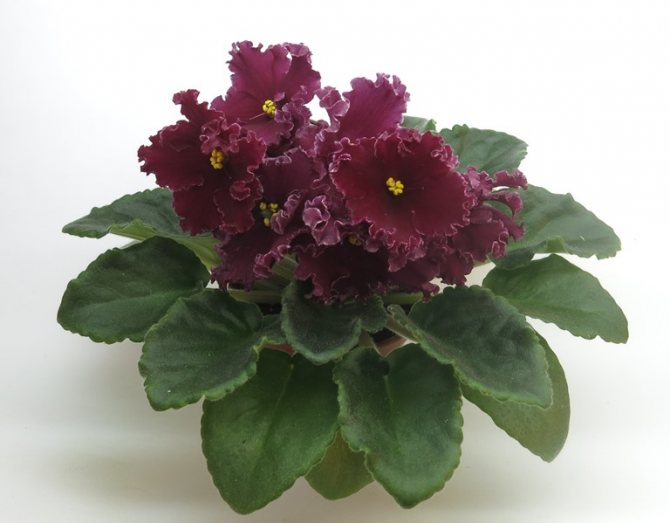

Saintpaulia Lilac, variety Lilac charm
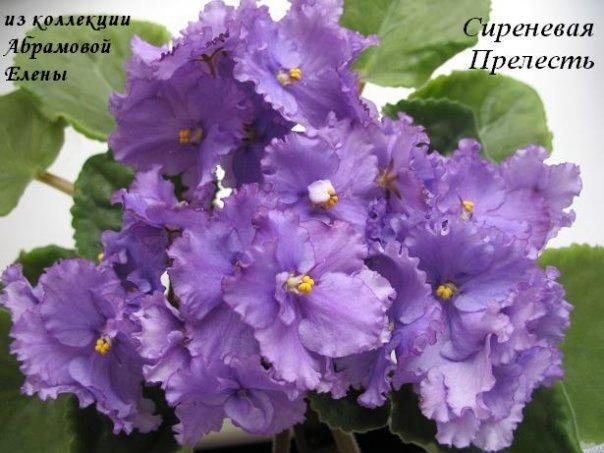

Terry Saintpaulia, variety Frosty cherry
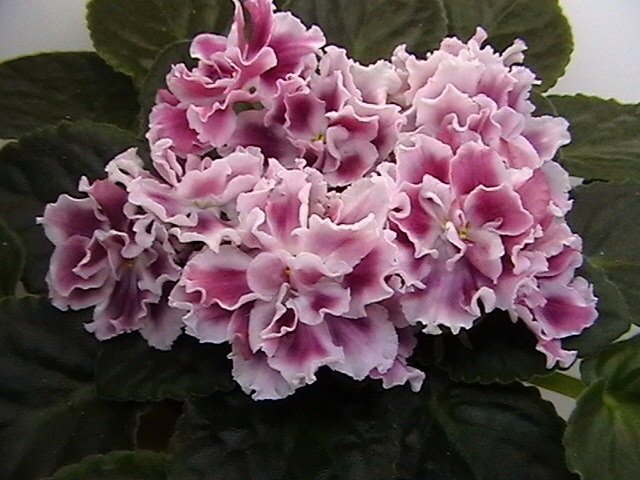

Saintpaulia Black, variety Black Pearl
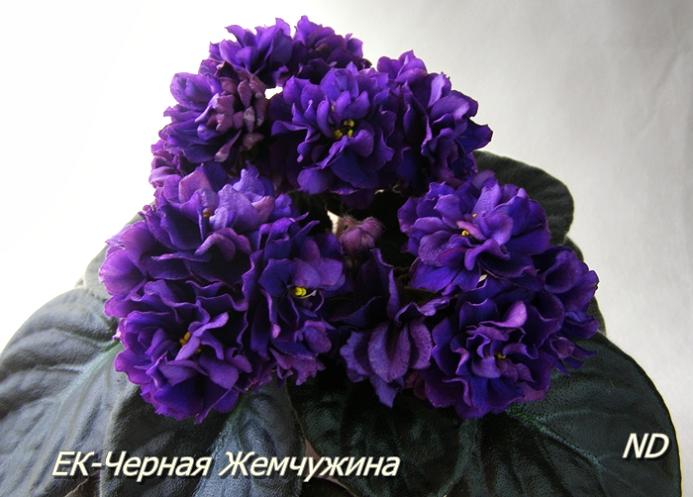

Saintpaulia ampelous
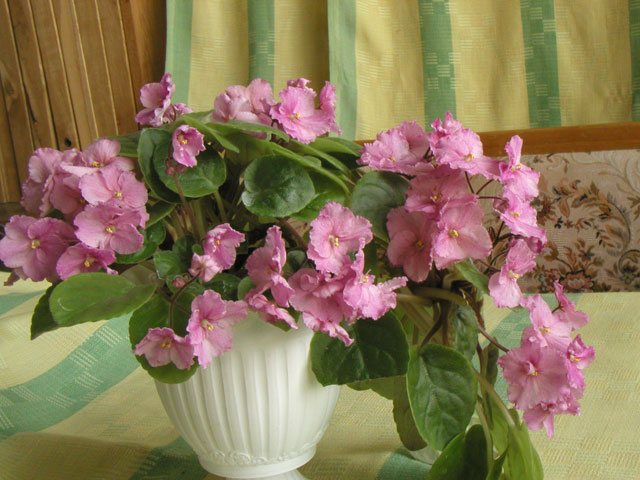

Sometimes she is sick, sometimes she suffers ...
It happens that the uzambar violets stop blooming and growing, wither and die.
Unfortunately, they are also susceptible to diseases and cannot always resist them:
- Powdery mildew expressed in whitish spots, ulcers and irregularities on the leaves, flowers and stems. Usually, the development of a fungal disease is triggered by high humidity and low temperatures in the spring. At the onset of the disease, spraying with "Topaz" all plants standing on the same windowsill with the diseased flower helps.
- Decay of roots manifests itself in the loss of elasticity by the leaves and the appearance of plaque on them. The reason is too abundant watering of the plant, moreover, with cold water. Ways to get rid of the problem are transplanting into new soil or rerooting the trunk.
- Late blight - a dangerous fungal disease that penetrates the plant through wounds and the root system. It becomes noticeable when the leaves lose their firmness and turn brown.At the beginning of the disease, the flower can be saved by cutting off all affected roots, leaves and flowers and transplanting the bush into new soil, avoiding excessive moisture. With an already developed disease, it is necessary to destroy the plant.


Diseases and pests of violets
DIFFICULTIES OF GROWING
There are no particular difficulties in growing violets. The main thing is to create conditions for her under which she can fully develop. It is necessary to protect it from drafts, changes in humidity and temperature, cold, direct sunlight. It is necessary to water the violet in moderation, feed it in the same way.
It is better to plant a violet in a clay or ceramic pot. Natural materials are breathable.
Watering can be done as follows: place the pot on a tray with damp absorbent material. The water through the hole in the pot will evenly flow directly to the roots of the plant.
The tools used to trim parts of Saintpaulia must be disinfected.
Soil and watering
Saintpaulia is a violet, watering and soil for which are important. The plant prefers loose soil with good water retention. The planting mixture consists of the following components:
- sod land;
- leaf humus;
- sand;
- sphagnum moss.
You can also use a ready-made store-bought mixture, but with the addition of perlite, moss or coconut substrate. Often gardeners add land from a coniferous forest, also mixing it with leaf.
For watering Saintpaulia, only settled water (tap or rain) is suitable. Preferring peat soil, the moisture from which evaporates quickly, the Uzambara violet also likes moderate watering, and overflow is even more dangerous for it than the lack of moisture. If water gets on the outlet, the stem and adjacent roots may start to rot. The best option is to add water to the pan or by immersing the pot in warm (room temperature) water.
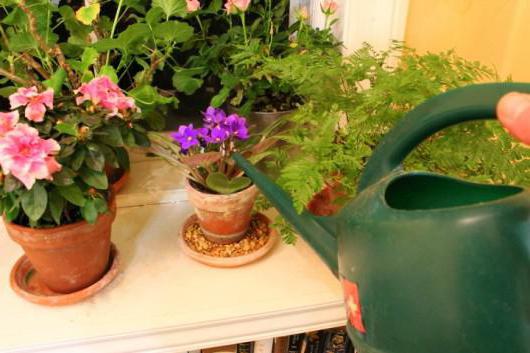

ANSWERS TO QUESTIONS FROM READERS
Life span
The life span of a violet with quality care can be infinite, provided the plant rejuvenates.
Can I keep it at home?
Saintpaulia, like any indoor flower, can be grown in an apartment, creating all the necessary conditions for it.
Is the flower poisonous?
The violet poses no particular danger to children or pets. This, of course, depends on the amount of the plant eaten. It is possible that the violet eaten can cause indigestion in cats.
Why isn't Saintpaulia blooming?
There are several reasons why the violet does not bloom. It can be unfavorable conditions, a disease of the plant, a large pot. Bad conditions include
- dryness
- cold
- heat
- excess nitrogen
- the plant has not been transplanted for a long time.
Why do the leaves turn yellow and dry?
The reasons may be
- poor quality watering
- hot sun
- dry air
- draft
Why do leaves rise?
If the violet leaves have lightened, their edges are bent, and they stretch upward, then, perhaps, a very low temperature has been created for the violet.
Why did you change the color?
Parts of the violet change color with increased soil density, insufficient lighting and watering. Hybrid varieties can change color due to mutation, genetics.
Why do the leaves curl?
Saintpaulia leaves curl when it is poured, placed in a very hot sun, fed incorrectly - too much or too little. Perhaps a cyclamen mite appeared on the leaves.
Frequent illnesses
Violet can be sick with infectious and non-infectious diseases provoked by various bacteria, viruses and fungi. The most common:
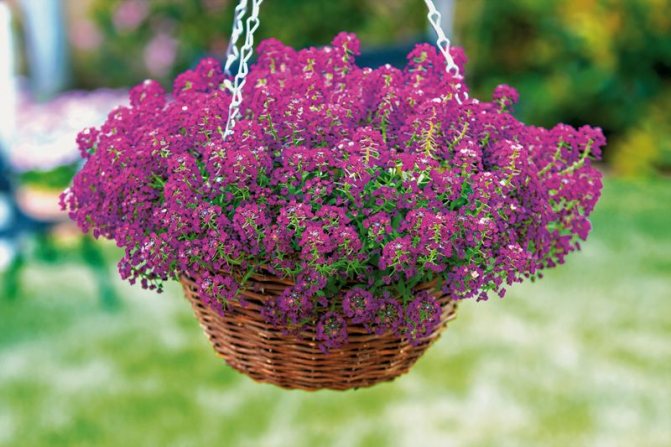

Gray rot is an infectious fungal disease in which the flowers become covered with gray mold, the affected areas of the plant die off. To prevent disease, you should strictly adhere to the watering regime, maintain the recommended temperature and humidity. Treatment is carried out with a weak solution of disubstituted sodium phosphate at the rate of 1 g per liter of water or other fungicides.- Powdery mildew is a fungal disease that forms a white coating on the leaves and flowers of Saintpaulia, which become as if dusted with flour. The disease occurs when there is insufficient light and low room temperature, as well as due to dust and dirt on plants and places where flowers are placed. For preventive purposes, it is necessary to maintain cleanliness and systematically wash the pots and trays with soapy water.
And also violets often suffer from decay of the stem and roots, wilting and decay of the lower leaves, spotting, yellowing of all leaves of the plant and dropping of flowers and buds.
To avoid common mistakes in growing uzambar violets, you just need to give them a little of your time and attention. Then bright multi-colored bushes will delight with their flowering all year round.
Why does spathiphyllum release leaves well, but completely stopped blooming
How to transplant a violet
For growing violets, rather wide pots are used, of small height, the size of the pot should correspond to the size of the plant. Young plants with only a few leaves (reproduction in spring) are planted in small pots, 5-7 cm in diameter. Then (in the summer), they are transplanted into large pots about 9 cm in diameter. Miniature varieties of violets are grown in pots 3-4 cm in diameter (these are sold under cacti in flower shops). The best pot for Saintpaulias is the one in which the height is the same as the width, since the roots of these plants do not grow deeply.
If you cannot decide on the size, we give a hint - the pot needs such a diameter that the leaves of the violet bush placed in it extend beyond it by half the length of the leaf or a little more. If saintpaulias are planted in pots that are too large, the probability of waterlogging is very high. The earth dries out for a long time, the roots rot, soil pests start up (puffs, springtails or mushroom mosquitoes).
Soil for violets should have an acidity of pH 5.5-6.5 - this is a weakly acidic reaction. There are many soil options for Saintpaulias, here are approximate ones:
- 2 parts of leafy land, 1 part of turf, 1 part of coniferous, 1 part of river sand, 1 part of vermiculite.
- 2 parts of leafy soil, 1 part of coconut substrate (from briquettes), 1 part of well-rotted humus flour, 0.5 part of chopped pine bark,
- 1 part of sod land, 1 part of coniferous land, 1 part of vermiculite, 0.5 part of coarse river sand.
- 5 parts store soil for violets (or universal), 1 part vermiculite, 1 part chopped sphagnum moss or chopped pine bark.
Leafy soil is harvested in early spring, in a birch forest, as soon as the snow melts, remove last year's leaf litter and scrape up the earth. Sod land can be dug in a meadow by removing the top layer of sod. Coniferous land, respectively, in the coniferous undergrowth. All soil must be sorted out from branches and leaves and must be sterilized in the oven (40-60 minutes) or in the microwave at full power (10-15 minutes). Sand should be used only coarse, washed, ideally - very small pebbles 1-2 mm. Sand and vermiculite are neutral and act as a baking powder.
You can also use purchased mixtures "Violet" and the like - more about soil for violets
Transport of purchased leaf cuttings
For transportation of leaf cuttings, it is convenient to use boxes, plastic containers or other containers that will not allow the cuttings to break when transported in public transport.
If such a container is not at hand, then ask the seller to inflate a plastic bag and tie it tightly, in this case the stalk will not be injured during transportation. If the leaves are broken during transportation, they must be removed from the outlet.


Interesting Facts
Some evidence that Saintpaulia is not a boring plant:
- Originally, Saintpaulia had purple flowers. Thanks to the efforts of breeders, Saintpaulias of various shades appeared.Recent achievements include salmon and yellow colors.
- The very first cultivar bred was saintpaulia with reddish-purple flowers.
- The first double varieties appeared in 1920.
- By 1946, breeders already had more than 20 varieties of Saintpaulia of various colors. Now there are more than 7 thousand varieties, and according to some sources - up to 32 thousand!
- There is a variety of Saintpaulia with the curious name Harry Potter. But there is no lightning scar on it.
- There is a version that Saint-Paul discovered the flower while walking with his bride.
- There is confusion in floriculture. Usambara violet Saintpaulia and Viola are not the same thing. Plants belong to different families: saintpaulia - to the Gesneriaceae family, and violet - to the Violet family.
The African guest of home windowsills continues to amaze flower growers with their variability and variety of varieties. Growing Saintpaulia is a chance for a floriculture neophyte to take up an unpretentious plant and at the same time achieve an amazingly beautiful flowering. Even professionals do not ignore Saintpaulia. Hunting is underway for its rare varieties, many are ready to buy fresh samples abroad.
Senpolia room: difficulties in care, recommendations


From time to time it is necessary to wash off the leaves from dust. Violet arrange a summer shower, protecting the growth point and the earth from water ingress. Then the flower is kept in the shade for 4 hours until it dries completely. Shower prevents pests.
So that the violet is always beautiful and lush, remove dry and yellowed leaves in time.
- Excess light - the rosette becomes flat, the leaves curl up, the peduncle decreases in size, flowering stops.
- With insufficient diffused sunlight, the petioles and peduncle lengthen, and the leaves stretch upward.
- If the leaves go up, the lighting is increased, when folding to the edge of the pot, the amount of light is reduced.
- Leaves turn yellow and spots appear - excess fertilizer, or insufficient watering.
The Gesnerian family. Homeland of Saintpaulias Uzambara mountains of Africa. This plant is a favorite of many flower growers. Natural uzambara violets are distinguished by a variety of colors and shapes of flowers and leaves. But thanks to collecting and selection, which lasted more than one century, so diverse and numerous varieties of violets were bred that whole catalogs were created to describe them. We will try to present the most necessary information about these wonderful plants. Although many who begin to breed Saintpaulias, they wonder what kind of variety has blossomed on their windowsill.
Biological description [edit | edit code]
Representatives of the genus are low-growing evergreen perennial herbaceous plants [4].
The stems are shortened, with a basal rosette of leaves.
Leaves are leathery, covered with villi, rounded, usually with a slightly unequal heart-shaped base, with a rounded or short-pointed apex. They can be either uniform green in color or spotted.
Flowers - with five petals, collected in a brush. There are two stamens. Gynoecium is paracarpous (that is, unilocular with wall placentation), of two carpels [2]. It has one pistil with an upper ovary.
Saintpaulia also has a calyx consisting of five sepals.
Give the flower what he loves and you will be happy
Some flower growers are disappointed with the condition of their newly acquired violets.
It doesn't matter where you got this little miracle, it was bought in a flower shop, or friends have shared the scion, it needs a certain amount of care that does not coincide with the care of other indoor plants.
Different kinds of flowers, different requirements. If the uzambar violet does not please you with its appearance or flowering, it means that she does not like caring for it.
The soil under the violet should always be slightly moistened, as soon as it dries up, it is necessary to water it.
Water is poured near the edge of the pot under the leaves, preferably with a watering can with a narrow spout.
Water should not get on the surface of flowers or leaves, salt stains may remain, and water entering the center of the outlet leads to its rotting.
Stagnation of water in the roots also leads to their decay - the violet is sensitive to gray rot.
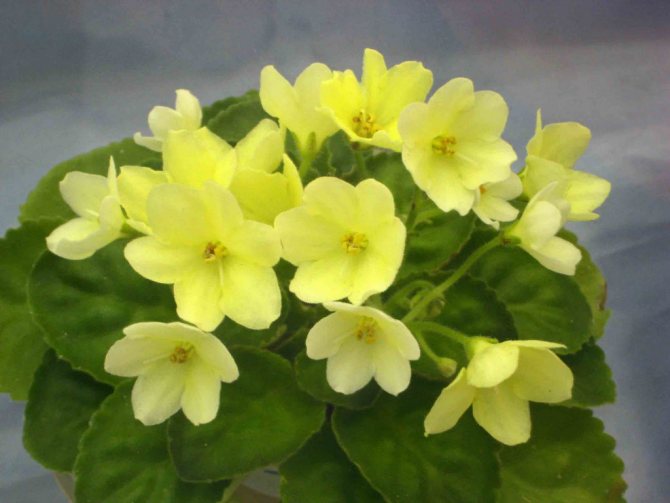

The water is used separated, warm (room temperature).
It is also a very important component of the care of Saintpaulia. By changing the location of the plant, you can regulate the intensity of its flowering and growth.
The Uzambara violet loves diffused bright light, but not the burning rays of the sun.
In the shade, the leaves will begin to stretch in length and upward, their color will darken, flowering will become less frequent, the color of the flowers will fade.
With an excess of lighting, the leaves, on the contrary, become smaller and nestle to the ground, the flowers also decrease in size.
In summer, on the windowsill of the south side of the house, Saintpaulia can get burns from the bright sun, while its leaves will be covered with yellow spots.
The beauty will be most comfortable on the west and east windows, although in the autumn and winter it is advisable to move her to the south side.
In spring and summer, southern windows should be shaded. Miniature varieties of Saintpaulia grow best near sunny windows.
Violets, standing on windows of any orientation, periodically need to be turned in their place to avoid tilting the outlet towards the window, because, like most plants, it stretches towards the sun.
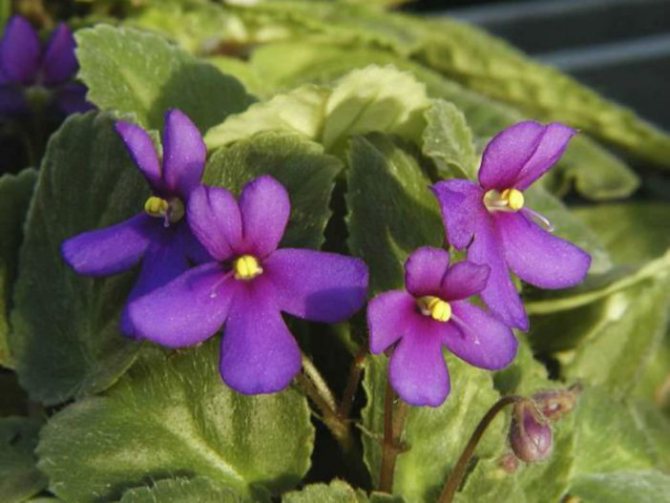

Plants on the window bloom most actively in March – May and September – October.
Variegated and dark-leaved violets need more intense lighting than Saintpaulias with light leaves.
Special phyto-lamps will help plants to feel good with a daylight less than 12 hours, then the flowering will be more extended.
Another point: if you grow violets under lamps away from the window, then at the time of flowering, the plant with pink, red or purple flowers is better to be rearranged on the windowsill (in summer - not to the south).
Under lively sunlight, the color of the petals will become brighter than it could have been under the lamp. In general, saintpaulias are plants that need to be rearranged several times in order to find the ideal place for growth and flowering.
The temperature of 20 ° С is optimal for the uzambara violet, the acceptable range is from 17 ° С to 23 ° С.
When the temperature drops to 16–17 ° C, the growth of rosettes slows down, but the shades of flowers become more saturated, strokes and spots appear on them brighter.
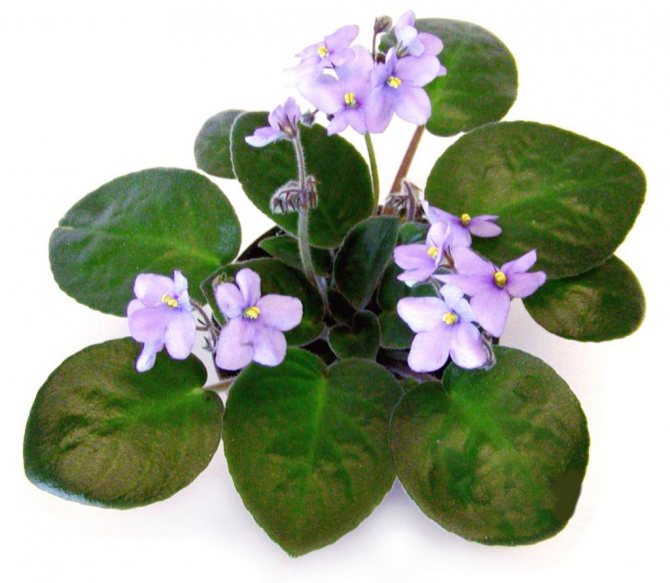

When the temperature norm is exceeded, the growth rate of the rosettes increases, the flowers actively bloom, but their color will be more blurred, the edges and edges will disappear.
At extreme temperatures for them below 13 ° C and above 30 ° C, Saintpaulias suffer and die. Avoid drafts from the vents in winter if there are these flowers on the window.
Flowers love humid air. You can soften dry air in winter with a room humidifier. Some pour water into the pan of the pot and pour a little expanded clay there. Water, evaporating from the stones, humidifies the air near the flower.
During intensive growth and flowering, the plant needs feeding. The stores sell ready-made fertilizer mixtures for flowering or ornamental plants.
Spraying and water treatments
The juicy delicate leaves of violets are very susceptible to bacterial and fungal rot, so the water remaining on the leaves is a great danger to them, as it can cause disease. You can spray only the air around the violets to increase its humidity, but drops of water should not fall on the leaves or flowers. It is not recommended to spray the plants themselves - this is more potential harm than good.
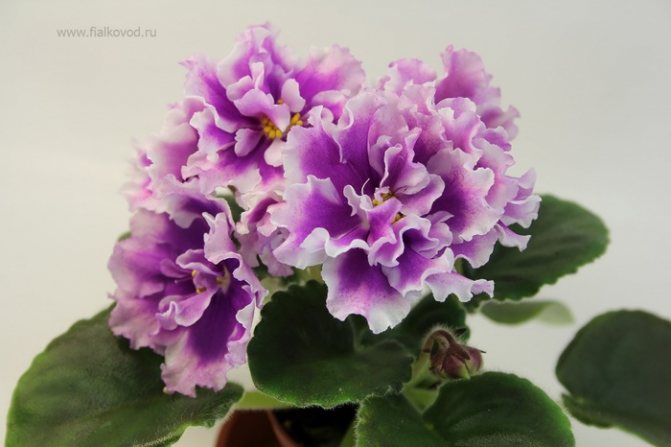

Over time, the leaves of any plants become covered with dust, which prevents them from breathing normally and interferes with photosynthesis. Therefore, periodically violets are carefully washed under the tap: they turn on slightly warm water, and with a stream of water they gently wash off all the dust from each leaf in turn. In no case should you rub the leaves with your hands, so as not to damage their delicate, fleecy structure.
Do not pour water into the growing point in the center of the outlet - this is very dangerous for the violets, as it can lead to decay and death of the plant. After water treatment, gently blot large accumulations of water on the leaves with a soft paper towel and place the violet in a warm, bright, draft-free place to allow the plant to dry quickly. It is impossible to wash the violet overnight and leave it to dry in the dark, this can provoke the appearance of fungal rot.


Saintpaulia in indoor floriculture [edit | edit code]
Varieties [edit | edit code]
Saintpaulia has long been used in indoor floriculture, and to date, many varieties of this plant have been bred. Most of them are hybrids of Saintpaulia violet ( Saintpaulia ionantha
), as well as interspecific hybrids
Saintpaulia ionantha
and some other types of Saintpaulia (
Saintpaulia magungensis
,
Saintpaulia comfusa
). In floriculture, a general name is sometimes used for all Saintpaulia hybrids.
Saintpaulia hybrid
(
Saintpaulia hybr> [7].
Saintpaulias varieties are divided into several groups, first of all, according to the color and shape of the flowers and their type. According to this principle, there are classic, star-shaped, fantasy, rimmed Saintpaulias and Saintpaulias-"chimeras".
By the type of leaves, plants are primarily distinguished as "boys" (English boy) and "girls" (English girl). In plants-"girls" on the upper side at the base of the leaf there is a light spot, in varieties of the "boys" group the leaves are completely green. The most common are Saintpaulias with rosettes, the diameter of which varies from 20 to 40 cm. There are giant varieties (diameter from 40 to 60 cm), miniatures (up to 15 cm) and even the so-called microminiatures; in the latter plants, the rosette diameter is only about 6 cm.
Modern varieties often convey varietal characteristics much worse than varieties of earlier breeding, for example, the selection of BM Makuni [8]
- Saintpaulia ‘Chimera Monique’ - the flowers of this variety have lilac petals with a white border.
- Saintpaulia 'Chimera Myrthe' - The flowers of this variety have pink-red petals with a white border.
- Saintpaulia ‘Ramona’ is a variety with deep pink double flowers with yellow anthers in the center.
- Saintpaulia 'Nada' is a white-flowered cultivar.
Violets from leaf cuttings and stepchildren reproduce
Reproduction of violets from leaf cuttings
The most common breeding method is by leaf cuttings. This requires a healthy, formed leaf (whether the mother plant blooms does not matter). The length of the petiole should be 3-4 cm, with an oblique cut.
It is better to put the stalk in water until the roots form. If the cutting is immediately planted in the ground, then, firstly, the soil should be loose, not compacted, and secondly, the cutting is placed in the soil to a depth of 1.5 - 2 cm, no more.
A pot with a handle is watered with warm water and covered with a plastic bag to maintain moisture, the temperature should be at least 20-21 ° C. Root formation and development of babies lasts 1-2 months.
Everyone can choose for themselves the most convenient, affordable and reliable way of rooting a violet stalk. If this method is not chosen very well, then sometimes beginners are disappointed when the stalk immediately rots and dies.
For home conditions, the most affordable way is to root the cuttings in boiled water. In cities where you can buy substrate components, many violet lovers root cuttings in agroperlite (large fraction) or vermiculite. Good results are obtained by rooting in finely chopped sphagnum moss.
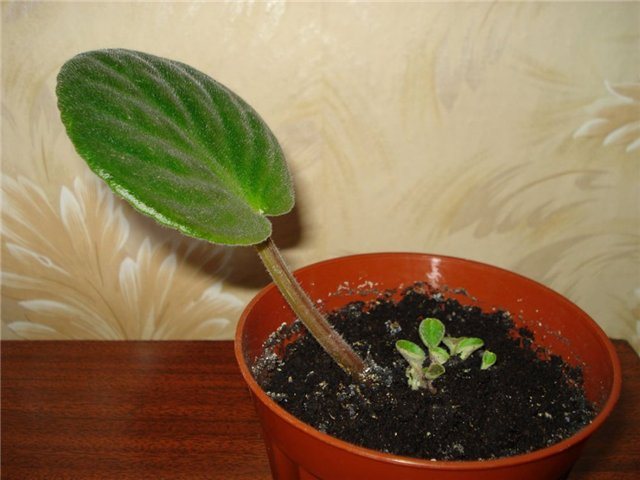

Many fans of violets root cuttings in peat-humus tablets, in which the risk of leaf decay is minimized.
The most general rule for all these methods is not to leave a long petiole. Babies will appear faster and larger if the length of the petiole does not exceed 4 centimeters. The cut must be done with a sharp razor or scalpel.
It is important when rooting the cuttings to provide increased air humidity and a temperature of + 20 ... 24 degrees C.It is recommended to put rooting cuttings in a greenhouse or in a plastic bag.
Babies appear on average after 4-6 weeks. When they get stronger and grow up, they will need to be carefully separated from the leaf, trying to minimize the injury to the roots of the baby. Then you should put the baby in a separate pot. The diameter of the baby pot should not exceed 6 cm. The leaf (if it is strong) can be put for re-rooting.
When planting the baby, it is necessary to put drainage (sphagnum moss, pieces of foam or small expanded clay) at the bottom of the pot. The soil for children should be loose and nutritious; 1/5 of vermiculite and 1/5 of perlite can be added to the substrate.
If there is sphagnum moss, then it should also be added to the substrate, having previously finely chopped with scissors, at the rate of 1/5 of the total volume of the mixture.
Planted children need to be placed in a mini-greenhouse so that the children adapt there for 2-3 weeks. Put the greenhouse with the children on a light windowsill (preferably not on the southern one, because there you need to shade violets so that there are no burns on the leaves).
In winter, make sure that there is no blowing from the window, because violets are very sensitive to hypothermia of the root system. Grown up children can be gradually accustomed to room conditions by airing the greenhouse with children for 10-15 minutes, then 30 minutes.


Reproduction of violets by stepchildren
For reproduction of violets, you can use not only leafy cuttings, but also stepchildren. For successful rooting, the stepson must have 3-4 leaves. To separate the stepson from the outlet, you need to have an awl or a sharp scalpel. When removing the stepson, you need to try not to injure the leaf cuttings of the main outlet.
To root the stepson, you can use a peat pill or a pot with a substrate. For better adaptation and early rooting, the planted stepson should be kept in the greenhouse for 3-4 weeks.
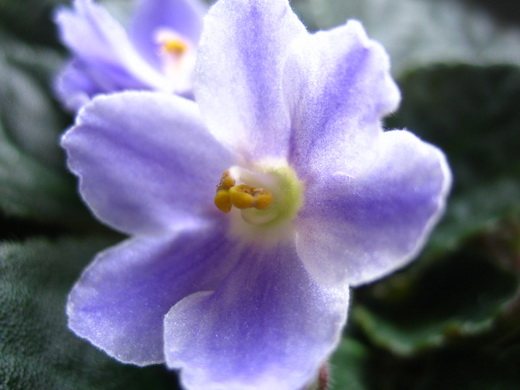

Indoor violet
Violets are classified primarily by the color and shape of the flowers and by the type of flower:
Simple violets have a five-petal corolla; the color can be very diverse. The classic violet has two upper petals slightly smaller than the lower and lateral ones:
Two-color violets - these varieties always have two colors on the background, rounded spots, without clear boundaries:
Bordered Saintpaulias have a border around the edge of the petal. The width and color of both the petals themselves and the border can be different (one or two colors). The width of the border is influenced by the room temperature. In hot conditions, the border may disappear completely, and when the plant is placed in cooler conditions, the border will appear again:
Chimera - these varieties of violets have stripes of different colors, diverging in the middle of the petal from the center of the flower. When propagated by leaf cuttings, the pattern is not transmitted, these violets are propagated by dividing the bush or side stepsons:
Fancy Saintpaulias - have a variety of blotches of different colors and shapes on their petals. But such violets are very demanding on the conditions of detention. If these conditions are violated, the flowers of fantasy violets acquire a monochromatic color. In addition, when fancy violets are propagated by a leaf cuttings, the color of the flowers is also lost or it does not appear completely:
Read also: What is the use of dogwood
Star-shaped type - the petals are all the same size, slightly pointed at the end, the shape of the flower resembles a star:
Some varieties of violets have additional underdeveloped petals in the center of the flower, and depending on the number of these petals, violets are classified as:
Semi-double violets - have 1-2 additional petals in the center:
Terry violets - with a large number of additional petals. The arrangement of these petals is different for different varieties, some take the shape of a ball, others are flatter:
In addition, Saintpaulias are classified by leaf type. Leaves can be pure green, with a white border around the edge, or spots - white or light green.Additionally, violets are distinguished as 'boy' - the usual green leaf from the petiole, and 'girl' - there is a light spot at the base. The ‘lance’ varieties have longer and sharper leaves at the end, the ‘spoon’ leaves have edges curled towards the top:
Leaves can also be smooth, corrugated, jagged or wavy. The pubescence of the leaves can also be different - there are smooth-leaved forms, there are densely pubescent and there are rarely pubescent.
Violets can also differ in the size of the whole plant. The most common "size" is 20-40 cm in diameter of the rosette, but there are also large varieties reaching from 40 to 60 cm, and there are miniature ones up to 15 cm, there are even microminiatures up to 6 cm in diameter. It should be noted that the size of the plant depends a lot on the size of the pot and the potting soil. On nutrient soil in a large pot, even a miniature violet will grow to medium size. There are also ampelous Saintpaulias, their foliage is more voluminous, and the stems fall off, hanging over the edge of the pot.
Care errors and their elimination
The most common mistakes when growing Saintpaulia and how to fix them:
| Problem | The reasons | Decision |
| Lack of flowering | Lack of lighting, excess nitrogen fertilizers, improper watering | Rearrange the flower in a brighter place, do not add nitrogen compounds during the budding period, do not overdry or overmoisten the soil |
| Yellowing of leaves | Sunburn, excess phosphorus in the soil | Provide bright diffused light, strictly observe the frequency and concentration of dressings |
| Dark spots on the leaves | Drafts, cold air | Do not allow the temperature to drop below + 18-20 degrees, do not put the flowerpot under the influence of drafts |
| Drying the leaves | Dry air | Keep the plant with an air humidity of at least 60% |
